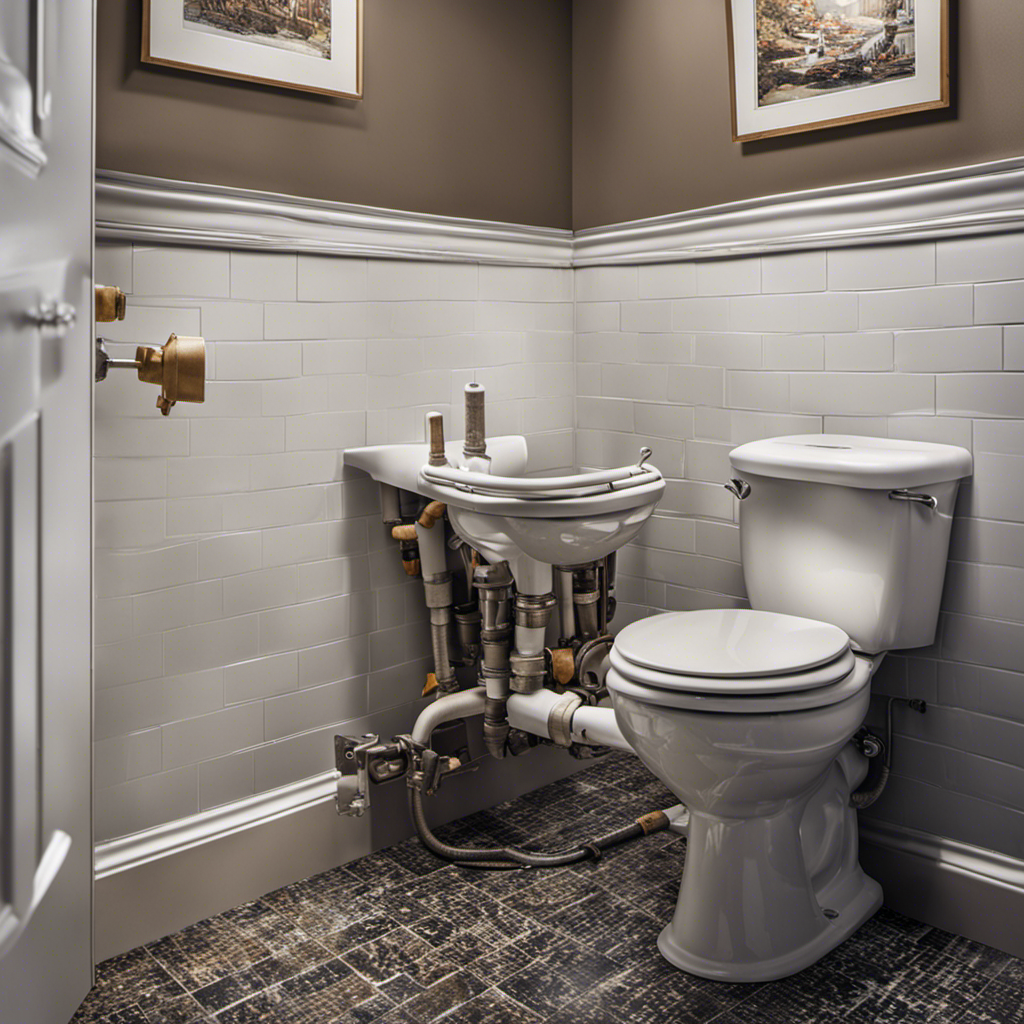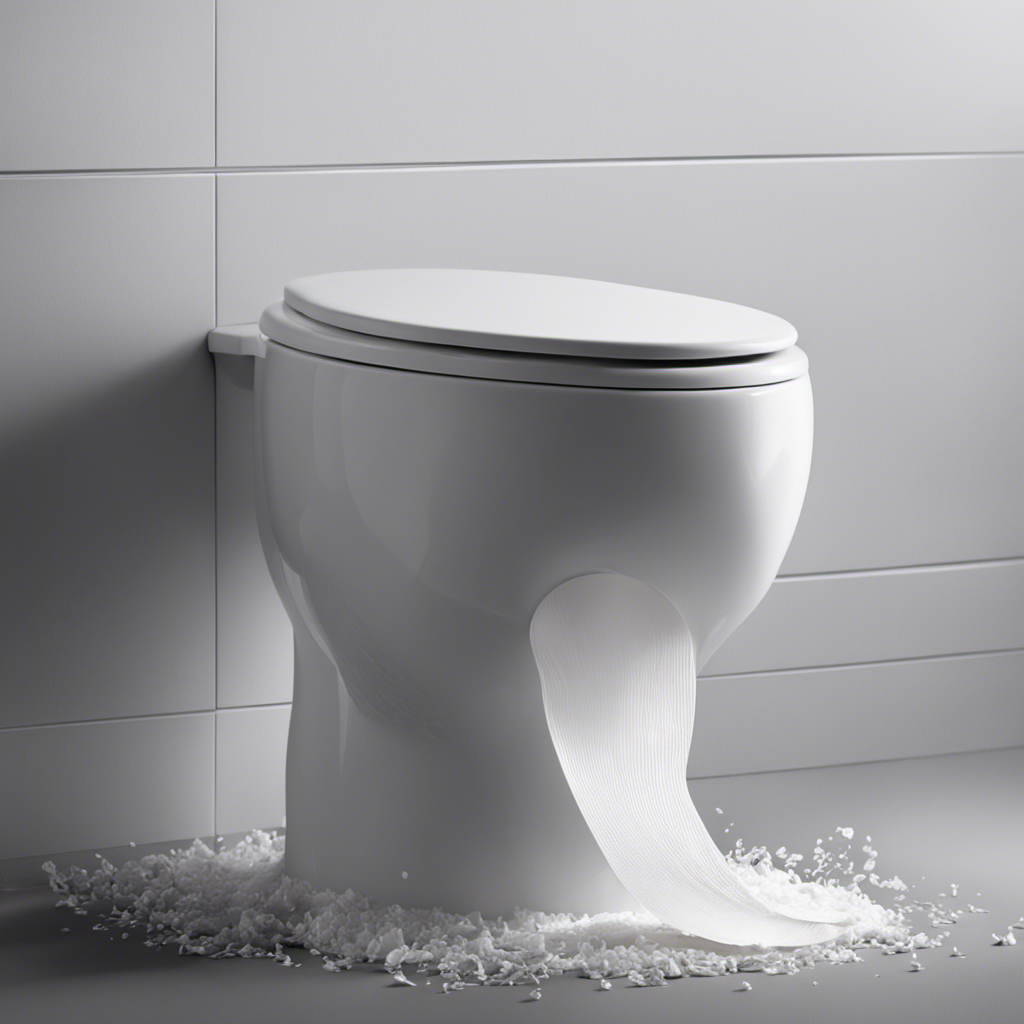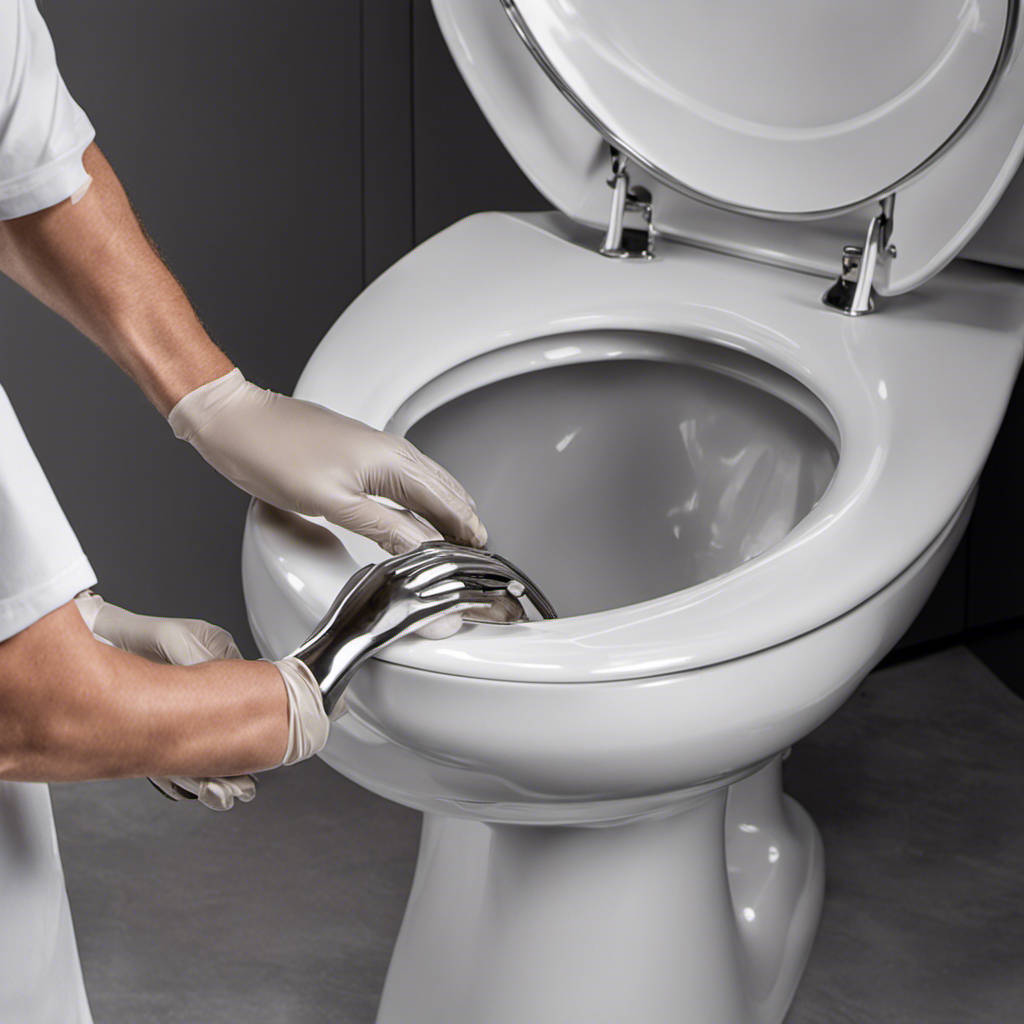Moving a toilet may seem like a daunting task, but I’m here to tell you that it’s not as hard as you might think. With a little know-how and the right tools, you can successfully relocate your toilet to a new position.
In this article, I will guide you through the process step-by-step, providing you with all the information you need to make this seemingly difficult task a breeze.
So let’s dive in and discover just how easy it can be to move a toilet.
Key Takeaways
- Familiarize yourself with the necessary tools and materials for toilet relocation.
- Understand the potential plumbing challenges and difficulties involved in moving a toilet.
- Assess the cost, time, and physical effort required for the project before starting.
- Consider seeking professional help or acquiring necessary skills and knowledge to overcome plumbing challenges.
Understanding the Basics of Toilet Installation
To understand the basics of toilet installation, you’ll need to familiarize yourself with the necessary tools and steps involved.
When it comes to toilet installation, there are a few common mistakes that people make. One of the biggest mistakes is not choosing the right toilet for your space. It’s important to consider the size of your bathroom, the location of the plumbing, and any special features you may want.
Another mistake is not properly measuring the rough-in distance, which is the distance from the wall to the toilet’s centerline. This measurement is crucial to ensure that the toilet fits properly and functions correctly.
By avoiding these mistakes and following the proper installation steps, you can successfully install a toilet in your bathroom.
Now, let’s assess the difficulty level of moving a toilet.
Assessing the Difficulty Level of Moving a Toilet
Assessing how challenging it is to relocate a toilet can help you determine if it’s a task you can handle. When it comes to moving a toilet, there are several plumbing challenges that you may encounter. It is important to be aware of these challenges and have the necessary skills and knowledge to overcome them. Some common challenges include dealing with plumbing connections, ensuring proper drainage, and maintaining the structural integrity of the floor. To give you a better understanding, here is a table highlighting some relocation tips and the associated challenges:
| Relocation Tips | Plumbing Challenges |
|---|---|
| Locate the new position for the toilet | Re-routing the plumbing connections |
| Check the existing drain and vent lines | Ensuring proper drainage and venting |
| Prepare the floor for installation | Maintaining structural integrity |
Tools and Materials Needed for Moving a Toilet
Before you begin relocating a toilet, make sure you have all the necessary tools and materials.
Moving a toilet involves a few key plumbing techniques and requires specific tools to ensure a successful relocation.
First and foremost, you will need a wrench or a pair of pliers to disconnect the water supply line and the toilet bolts.
Additionally, a putty knife will come in handy to remove the old wax ring and any residual caulk.
To secure the toilet in its new location, you will need a new wax ring and toilet bolts.
It is also recommended to have a level to ensure the toilet is properly aligned.
Finally, don’t forget to have a bucket and towels nearby to catch any water spills during the process.
Step-by-Step Guide to Disconnecting a Toilet
Disconnecting a toilet involves using a wrench or pliers to detach the water supply line and toilet bolts. It is a relatively simple process that can be done by a skilled DIYer. However, before attempting to move a toilet, it is important to assess the cost, potential risks, and challenges involved.
Here are some key points to consider:
-
Assess the cost: Moving a toilet may require additional plumbing work, such as extending or rerouting pipes. Consider the cost of materials and labor before making a decision.
-
Potential risks: Moving a toilet incorrectly can lead to leaks, damage to the flooring, or even structural issues. It is crucial to have a good understanding of the plumbing system and the proper techniques for relocation.
-
Finding professional help: If you are unsure about the process or lack the necessary skills, it’s best to seek professional help. Plumbers have the expertise and tools to safely move a toilet and ensure everything is done correctly.
-
Permits and regulations: Depending on your location, there may be permits and regulations that need to be followed when relocating a toilet. It is important to research and comply with these requirements to avoid any legal issues.
-
Time and effort: Moving a toilet is a time-consuming task that requires careful planning and execution. Consider whether you have the time and physical ability to complete the project on your own.
Strategies for Moving a Toilet to a New Location
When considering relocating a toilet, there are several important plumbing considerations to keep in mind.
Firstly, you will need to determine if the new location has the necessary plumbing infrastructure in place, such as drain lines and water supply connections.
Additionally, you will need to gather the appropriate tools for the relocation, including a wrench, pliers, and a putty knife.
Lastly, there are specific steps that need to be followed to successfully move the toilet. These steps include shutting off the water supply, disconnecting the water and drain lines, and carefully lifting and repositioning the fixture.
Plumbing Considerations for Relocation
To ensure a successful relocation of the toilet, you’ll need to consider the plumbing aspects involved. Here are some important factors to keep in mind:
-
Assessing relocation costs: Before starting the project, it’s crucial to evaluate the overall expenses involved in moving the toilet. This includes the cost of materials, labor, and any necessary permits.
-
Planning for plumbing modifications: Relocating a toilet requires making changes to the existing plumbing system. This may involve rerouting pipes, adjusting the drain line, and installing new water supply lines. Careful planning is necessary to ensure proper functionality and prevent any potential issues.
-
Securing professional assistance: Depending on the complexity of the project, it’s advisable to hire a licensed plumber to handle the relocation. They have the knowledge and expertise to navigate the plumbing modifications effectively.
-
Obtaining necessary permits: Check with your local building department to determine if any permits are required for moving a toilet. Compliance with building codes is essential to avoid future problems.
-
Considering future maintenance: When relocating the toilet, make sure to consider accessibility for future repairs or maintenance. Easy access to the plumbing system will save you time and effort down the line.
Considering these plumbing considerations will help ensure a smooth and successful relocation of your toilet. Now, let’s move on to the tools needed for the relocation process.
Tools Needed for Relocation
Before starting the project, it’s important to gather the necessary tools for the relocation of your toilet.
Relocating a toilet can present some challenges, especially when it comes to the plumbing requirements.
To ensure a smooth and successful relocation, you will need a few specific tools.
First and foremost, you will need a wrench to disconnect the water supply line and remove the bolts holding the toilet in place.
Additionally, you will need a scraper or putty knife to remove any old wax or caulk from the base of the toilet.
A plunger may also come in handy to clear any clogs that may occur during the relocation process.
With these tools in hand, you’ll be ready to tackle the steps for moving your toilet.
Steps for Moving Toilet
Moving a toilet may seem like a daunting task, but with the right steps, it can be done efficiently. Before starting, it’s important to assess the difficulty level of the job and consider the plumbing implications of relocating the toilet.
Here are the steps to follow:
- Turn off the water supply to the toilet.
- Empty the toilet bowl and tank by flushing and sponging out any remaining water.
- Disconnect the water supply line and remove the bolts securing the toilet to the floor.
- Carefully lift the toilet off the flange and move it to the new location.
- Install a new wax ring on the flange and place the toilet back on top, aligning it with the bolts.
Reconnecting a Toilet in Its New Position
Once you’ve positioned the toilet in its new spot, you’ll need to reconnect the water supply and secure it in place.
To reconnect the toilet securely, start by attaching the water supply line to the bottom of the tank using a wrench. Make sure it is tightened properly to prevent any leaks.
Next, position the wax ring on the flange and carefully lower the toilet onto it, ensuring that the bolts align with the holes on the base. Once in place, apply downward pressure to create a proper seal.
Secure the toilet by tightening the nuts onto the bolts, but be careful not to overtighten and crack the base.
Finally, connect the water supply line to the shut-off valve and turn the water back on.
Troubleshooting Common Issues When Moving a Toilet
When moving a toilet, there are several important plumbing considerations to keep in mind. This includes ensuring that the new location has access to the necessary water supply and drainage lines, as well as evaluating the existing plumbing system for any potential issues or modifications needed.
Additionally, flooring challenges may arise during the relocation process, such as the need to match or replace existing flooring materials. Solutions for these challenges may involve using specialized tools and techniques to seamlessly integrate the toilet with the new floor.
Lastly, structural modifications may be required to accommodate the new toilet position, such as adjusting the framing or reinforcing the floor to support the weight of the fixture.
Plumbing Considerations When Moving
One important thing to consider when moving a toilet is the plumbing. Assessing plumbing challenges is crucial to ensure a successful relocation of bathroom fixtures. Here are some key points to keep in mind:
-
Check the existing plumbing layout: Understanding the current plumbing configuration will help determine the feasibility of moving the toilet. Evaluate the distance between the toilet and the existing waste pipe.
-
Consider the venting system: Ensuring proper ventilation is essential for preventing sewer gases from entering the bathroom. Evaluate the location of the existing vent stack and determine if it can accommodate the new toilet location.
-
Assess the water supply: Relocating a toilet may require extending or rerouting the water supply line. Consider the accessibility of the existing water supply and determine if modifications are needed.
-
Plan for drainage: Moving a toilet may require adjusting the drainage slope to ensure proper waste removal. Evaluate the existing drain pipe and determine if it can be modified to accommodate the new toilet location.
-
Consult a professional plumber: If you are unsure about the plumbing challenges involved in moving a toilet, it’s always best to consult a professional plumber. They have the expertise to assess the situation and provide guidance on the best course of action.
Flooring Challenges and Solutions
To successfully address flooring challenges when relocating your bathroom fixtures, you should evaluate the condition of the existing floor and determine if any repairs or modifications are necessary. Some common flooring challenges include uneven surfaces, different heights between the old and new fixtures, and the need to match existing flooring materials. To overcome these challenges, there are several relocation strategies you can employ. One option is to remove the existing flooring and install new flooring throughout the entire bathroom to create a seamless look. Another option is to carefully remove the old flooring around the fixtures and replace it with new flooring that matches the rest of the room. Additionally, you may need to consider potential structural modifications needed to support the relocated fixtures. By evaluating the flooring challenges and implementing the appropriate relocation strategies, you can ensure a successful and functional bathroom renovation.
| Flooring Challenges | Relocation Strategies |
|---|---|
| Uneven surfaces | Remove and replace flooring throughout bathroom |
| Different heights | Carefully remove old flooring around fixtures and replace |
| Matching materials | Use new flooring that matches existing room |
| Structural support | Consider potential structural modifications as needed |
Potential Structural Modifications Needed
Moving a toilet may seem like a simple task, but it can sometimes require structural reinforcements and cost considerations. When relocating a toilet, it’s important to assess the existing plumbing and ensure that it can accommodate the new location. This may involve extending or rerouting the plumbing lines, which could require additional structural modifications.
Reinforcing the floor may be necessary to support the weight of the toilet and prevent any potential damage to the surrounding area. Additionally, the cost of moving a toilet can vary depending on the extent of the structural modifications needed. Factors such as the distance between the current and new location, the complexity of the plumbing work, and the materials required for reinforcement can all impact the overall cost.
- Assess existing plumbing
- Extend or reroute plumbing lines
- Reinforce the floor
- Consider potential damage to surrounding area
- Evaluate cost of structural modifications
Conclusion
In conclusion, moving a toilet is no easy feat. It requires careful planning, the right tools, and a lot of physical exertion.
It’s like navigating a labyrinth, where every step must be calculated to avoid pitfalls. But fear not, with the right guidance and determination, it can be done.
Just like a skilled architect crafting a blueprint, you can successfully relocate your toilet to its new home.
So roll up your sleeves, grab your wrench, and embark on this plumbing adventure!










